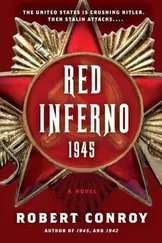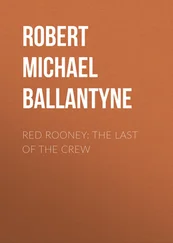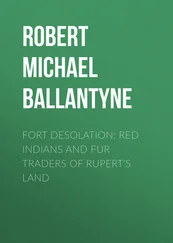It’s a young, turbulent ecosystem. The invasion of Mongolian dinosaurs, and of species from the other direction - from western Europe - has upset an ecological organization many millennia old. The new arrivals seek to establish themselves, stake out territories, protect their food resources, and raise young. But the breeding groups of old-time native species refuse to give up real estate to the invaders. So populations of native and invader are jostling each other, and predator packs are moving hundreds of miles each season, far more than they would in a normal year.
As the sun sets, coloring the dust clouds kicked up by distant herds, the adult raptors become more alert. The stream valley is so richly stocked with game that many species of predator - large, medium, and small - are being drawn in.
Late one afternoon, Raptor Red can see silhouettes of meat-eating dinosaurs far away on the horizon. Their body forms are outlined with great sharpness and clarity - as if they were paper cutouts hung in a picture window looking out on the sunset. The distant predators walk slowly, then sit down, flexing knees and ankles.
Both Raptor Red and her sister pay very close attention to how the unknown predators sit. Raptors sit upright. They have a big cushiony pad of tough skin below and behind their hips. The cushion lies directly below the huge pubic bone, longest and strongest of the hip elements. Since the cushion is oriented aft and downward, raptor torsos are held nearly erect when the raptors are relaxed in sitting position.
Only raptor species sit this way. All other predators have a built-in pubic cushion that goes straight down from in front of the hips, at a right angle to the backbone. When these nonraptors sit, they lower their torsos into horizontal position.
One by one the five distant predators sit. Each one lowers its compact torso straight down. Each one sits with its shoulders close to the ground.
The predators are too far away for the Utahraptors to judge their size directly. But shape is a clue to size.
Not our kind, the sisters think. Too big - danger. The sisters can see that the unknown predators have short thick necks and deep heavy muzzles. Those shape contours belong to ridge-backed Acrocanthosaurus, giant carnivores that are three tons full grown. Five acros are fifteen tons of unstoppable muscle, tendon, teeth, and jaws. The giant predators hardly ever travel in groups of four or more. These five are brothers from one brood who have not yet split up to find individual mates. Such bachelor packs can be unpredictable and violent.
The raptor family stays where it is, but both adults rest with eyes half open and nostrils flared. The acros don’t stir at all during the night.
Hssssssss - grhp! The raptor sisters rouse the chicks before daybreak and nudge them into movement. The wind has shifted, and the irresistible smell of the Astrodon calf that the raptors killed the day before has reached the five acros. They are getting up, stretching, making high-pitched calls to advertise their presence to any female acro who might be nearby.
Food and courtship are now conflicting calls for these acros. Two wander away, tracking the scent of a female acro. The three others start toward Tick-Bird Meadow at a fast clip.
The raptor pack leaves the meadow. It’s foolish to contest the Astrodon carcass with three acros. Besides, there isn’t much meat left on its body, and hunting should be good elsewhere in the valley.
The raptor sisters move on a couple of miles. Then they start looking for another big kill - something at least a ton. It’s much more economical than trying to feed the pack assorted lesser fry, like turtles, crocs, fish. They spot another iguanodon herd - the valley is overrun with them - and creep around to the upwind side.
Raptor Red and her sister are just getting into a superb ambush position, hidden in deep reeds by a spring, when a head pops up abruptly a few yards away and stares at them. It’s a raptor head - with a red muzzle.
Another red-muzzled raptor snout pokes up. The sisters realize that they aren’t the only pack trying to ambush the iguanodons.
There’s no noise. Neither pack wants to spook the iguanodons.
Raptor Red is confused. Her sense of smell tells her that both new raptors are young males -and not close blood kin. She doesn’t detect any new females nearby. The two males are non-threatening.
They lower their heads in a quiet head-bob-head-weave. It’s a tentative greeting and a prelude to courtship.
Raptor Red wants a new mate. Her biological urge to bond, brood, and raise chicks of her own is (becoming more insistent every day. She hasn’t forgotten her lost mate. But she feels a calling to get on with her reproductive duties - the highest calling any dinosaur can have.
One of the males advances and begins a more formal courtship dance. He’s lithe and graceful and healthy, with smooth motions and not a hint of injury or disease to mar his performance.
Raptor Red watches coyly. She’s heavier than he is, and stronger. All Red Snout females are strong enough to repulse most males. Raptor Red is programmed to make the male prove that he’s worthy, that his genes are worthy for making healthy raptor chicks with her.
The male would score a perfect 10 in difficulty from an Olympic Utahraptor judge - he manages to go through the entire courtship ritual without making any loud sounds or movements that the iguanodons could see.
This one, this male - very, very, smart. Raptor Red has been courted several times before, but never with such a bravura combination of stealth and exuberance.
She’s making up her mind to forget the hunt for today. She can kill tomorrow …
HssssSSSS. The iguanodon cows stop feeding, turn their heads, and bellow deep alarm sounds. A stampede begins.
HSSSSS. Raptor Red’s sister holds her body high, making exaggerated strides toward the males, flicking her curved handclaws in and out.
Raptor Red blinks. Her sister is making a full-fledged threat display. She wants to hurt the two males.
The older chick, who was hiding some distance away, wanders up behind its mother and tries to imitate her hissing malevolence.
The male looks surprised; his pupils dilate at the sight of the chick. He lowers his body as far as he can and starts to back away.
Now Raptor Red is pulled by conflicting instincts. She wants that male. He’s the finest male she’s ever seen - or at least the finest she can remember. She cannot join in her sister’s attack.
But she can’t leave her sister’s chicks either. Raptor Red watches as the mates withdraw. Her sister returns, still visibly agitated.
Raptor Red and her sister resume hunting late in the day and kill a plump iguanodon cow. As they sit down to eat the best parts first, Raptor Red can smell the young male nearby, hiding in a ravine. Later on, his scent gets fainter and fainter.
Her sister comes over to her and lies down. Raptor Red looks at her. She nuzzles Raptor Red and starts to groom her behind her ears, making delicate little bites.
THE TURTLE OF TRINITY
LATE MAY
It’s midnight, but Raptor Red is wide awake because she’s curious. Something is going on in the pond, and she wants to know what it is. She’s been staring at a V-shaped series of tiny waves that means a living animal is moving just under the surface.
Flip! Up comes a little black scaly face, pushing its armored eyebrows just above the pond’s surface. The moonlight catches the crests of the delicate ripples widening as they pass outward from the disturbance. Pop! The eyes open, and a pair of orange-red pupils stare at the shore, where Raptor Red is hunched down, motionless but awake.
Pip! A bubble of air grows quickly at the tip of the back snout, pauses for a second, and bursts.
Читать дальше












